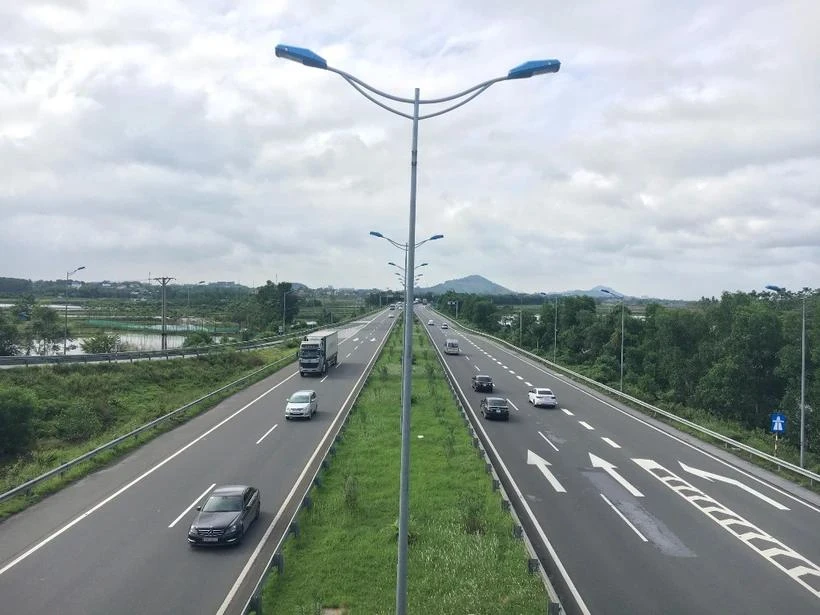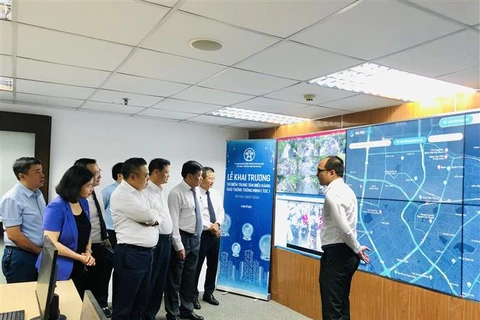
Hanoi (VNA) - The Intelligent Transport System (ITS) is defined as the key to promoting efficiency in the management and operation of highways and improving traffic capacity, thus helping to minimise traffic congestion, accidents, and environmental pollution and enhance vehicle owners’ compliance with traffic regulations.
In the coming time, as thousands of kilometres of highways will be put into operation, it is a "ripe" opportunity for Vietnam to invest in a modern and synchronous ITS to ensure connection in management, exploitation, and operation of the motorways.
According to Lam Van Hoang, Director of the Vietnam Expressway Authority under the Ministry of Transport, ITS is a system that applies sensors, electronics, information technology, and telecommunications to control the most optimal transport infrastructure systems. It can help improve traffic capacity, minimise traffic congestion and accidents, and reduce fuel consumption.
Hoang said that the ITS uses advanced information and telecommunications technology to link people, traffic systems, and vehicles on the road into an information-telecommunications network. This ensures management, operation, exploitation and circulation are handled in the most optimal manner on expressways. The main goal of the ITS system is to automate traffic management.
He acknowledged that the ITS also manages traffic information, infrastructure, electronic payment, and detection of traffic incidents to prompt response to incidents on highways. The system will help raise awareness of those in traffic, contributing to building a safe, civilised, modern, and developed society.
According to the planning scheme, Vietnam’s expressway network includes 41 routes with a total length of more than 9,000km. To date, the country has put 35 expressway routes and sections into operation with a total length of 2,000km. It is expected that the country will have 3,000km of expressways by 2025, and 5,000km by 2030. Thus, the ITS is an inseparable part of the expressway project, playing an equally important role compared to other construction items on specific routes.

Implementing the Prime Minister's request, the Ministry of Transport has defined a research roadmap and overall model for management, operation, and maintenance of smart traffic systems that include a traffic management and operation system, a traffic control system, a non-stop electronic toll collection system, and a vehicle load checking system.
At the same time, the project has also proposed an implementation roadmap suitable to Vietnam's conditions, ensuring effective exploitation of the expressways. It also includes amendments to legal documents, the development of ITS standards, the building of national ITS architecture, and an orientation on investment plans. Also part of the plan is the management and exploitation of the National Traffic Management and Operation Centre.
The Ministry of Transport has directed units to review and invest in completing the ITS system and the Route Traffic Management Centre for the eastern North-South expressway project. At the same time, the ministry also requested localities and the Commission for the Management of State Capital at Enterprises to direct specialised construction agencies, investors, and consultants to review, research, and deploy investment in the ITS and the Route Traffic Management Centre.
He acknowledged that recently, Minister of Transport Nguyen Van Thang has thoroughly directed the Vietnam Expressway Authority, agencies, and units under the ministry to organise working delegations to other countries in Europe and in the region to learn and share experiences in developing system models, engineering technology, equipment, and experience in investment, construction, management, operation, and exploitation of ITS systems. The ministry requires units to invest in a system of modern equipment during the implementation process, apply advanced technologies of the world, and synchronise the system of technical standards.

Route traffic control centres have been built according to the plan of combining adjacent short routes. There will be one traffic management and control centre for an average of 70-100km in order to improve the efficiency of management and operation. The centres use shared software that has integrated other traffic management subsystems for synchronisation. There is a shared data connection system to exchange information and interact between routes. In the immediate future, when the National Traffic Operations Centre is built, a capable route centre will be selected to connect and share information among the remaining centres.
Vietnam has initially mastered the technology, design, construction, and installation of ITS systems on highways. This will be the "ripe" time to form a methodical transport system for effective management, operation, and exploitation./.






















